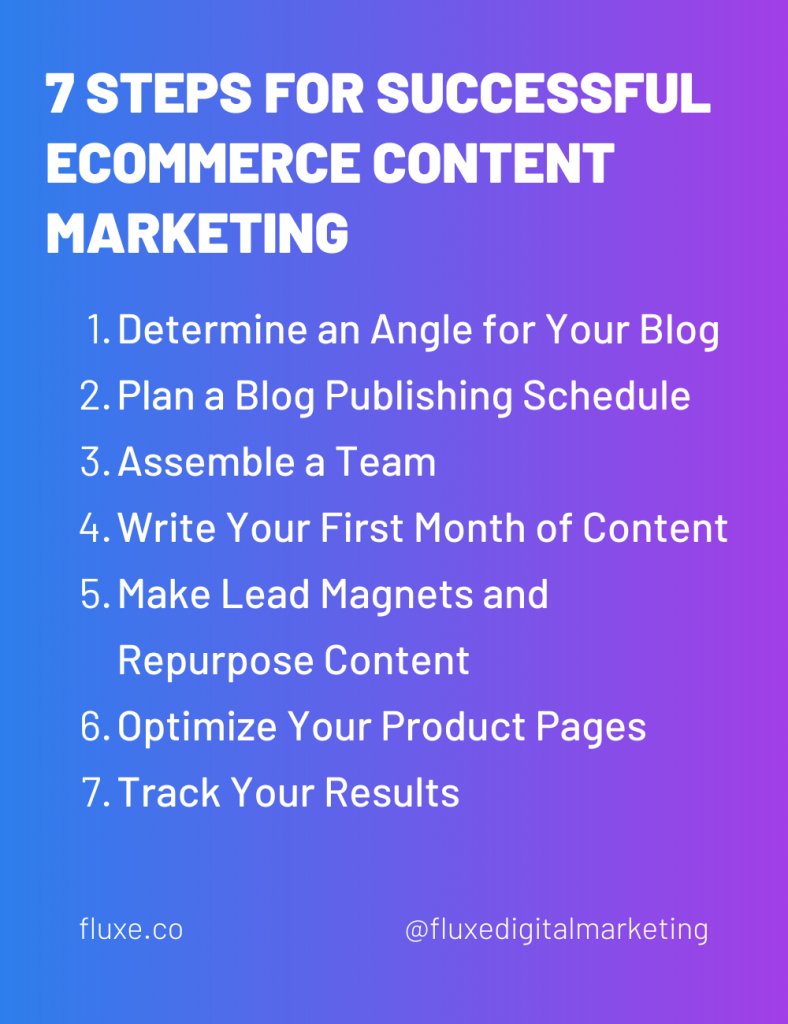Most ecommerce brands rely heavily on paid advertising. It’s trackable, fast, scalable, and lucrative, but it’s also expensive and short-term because of shifting markets and ad fatigue.
Overreliance on paid ads is risky, and surviving takes a strong, flexible strategy.
At Fluxe Digital Marketing, we’ve generated seven-figure annual recurring revenue for our ecommerce clients through strategic ecommerce content marketing. Here’s how you can do the same.

7 Steps for Successful Ecommerce Content Marketing
Step #1: Determine an Angle for Your Blog
Your blog should be an invaluable resource for your target audience.
If you sell hunting and cooking knives, make your blog the go-to resource for all things hunting and cooking. If you sell skincare products, your blog should be a treasure trove of skincare tips, advice, and insights.
Conduct keyword research to determine what information your customers are searching for, and use that knowledge to guide your blog topics. An effective ecommerce content strategy starts with understanding your audience’s needs and delivering the insights they crave.
Step #2: Plan a Blog Publishing Schedule
The further ahead you plan your topics, the better. “Starting a blog” sounds easy, but it’s difficult to overestimate the amount of work involved in research, writing, editing, formatting, and all the subsequent steps.
Consistency is key to a successful ecommerce content strategy. Plan your publishing schedule and stick to it. Whether you publish once a week or twice a month, maintain that rhythm. Your audience (and the algorithm) will come to expect your content regularly. Don’t disappoint them.

Step #3: Assemble a Team
Creating high-quality content consistently is no small feat. You need subject-matter experts, whether in-house or external. Assign tasks to everyone on your team, including drafting, editing, proofreading, image creation, uploading/publishing, and social media promotion.
A well-organized team is the backbone of effective ecommerce content marketing. At Fluxe, each client receives a full content marketing team, so they don’t have to stress over strategy and execution. This shortens the timeline from introduction to trust and lets business owners focus on what they do best — running their businesses.
Step #4: Write Your First Month of Content
Consistency trumps quantity. If you can consistently publish twice a month, that’s better than aiming for four times and missing deadlines. Set yourself up for success by choosing a publication frequency you can maintain.
That said, volume matters. The more content you have live, the more traffic and sales you can generate. Stay ahead of schedule to avoid missing publication dates.
At Fluxe, we use project management software to ensure we never miss a deadline. We haven’t missed a publication date in our 15 years of business.
Step #5: Make Lead Magnets and Repurpose Content
Your blog content shouldn’t live in isolation. Repurposing content is a smart ecommerce content strategy that maximizes the impact of your efforts.
Use it in social media posts, email newsletters, and other marketing channels. Create videos, infographics, and other engaging formats to get more mileage from each piece of content.
A lead magnet, like an ebook encompassing your best work, can make the most of your newfound organic traffic. It’s a powerful way to capture leads and nurture them into customers.
Step #6: Optimize Your Product Pages
As Google starts recognizing your site as an authority in your niche, your product pages will gain more keywords and traffic. This is the perfect time to improve your product pages’ SEO.
Optimized product pages are a crucial part of content strategy for ecommerce. They help your products rank higher in search results, driving more targeted traffic to your site. Ensure your product descriptions are detailed, informative, and optimized for relevant keywords.
Step #7: Track Your Results
Tracking results is essential for refining an ecommerce content marketing strategy and ensuring long-term success. Set up your Google Analytics 4 account to track ecommerce conversions, and use tools like Ahrefs to learn what’s working and what needs improvement.
A rapidly growing keyword list indicates a healthy SEO campaign. You’ll rank for more relevant keywords as Google’s algorithm gets to know your site’s content.
But be prepared for algorithm updates — they’re inevitable. Twelve to eighteen months into a successful campaign, you’ll likely take your first algorithm update hit. After a period of recovery, you’ll know your minimum monthly baseline for organic revenue and be able to plan accordingly.
Apply an Ecommerce Content Marketing Strategy in Your Sleep
At Fluxe Digital Marketing, we transform our clients’ expertise into powerful, trust-building content. We understand ecommerce content marketing’s unique challenges and opportunities, and we have the track record to prove it.
Let us help you unleash the full potential of your ecommerce business with a comprehensive content marketing strategy. Our team of experts will work with you to identify your unique value proposition, create compelling content, and drive measurable results.
Reach out today to start your journey to seven-figure success.



